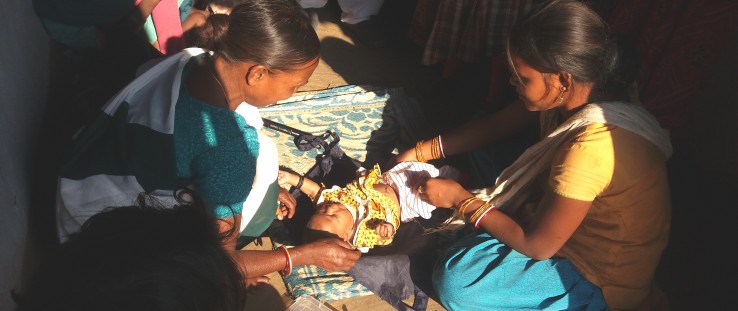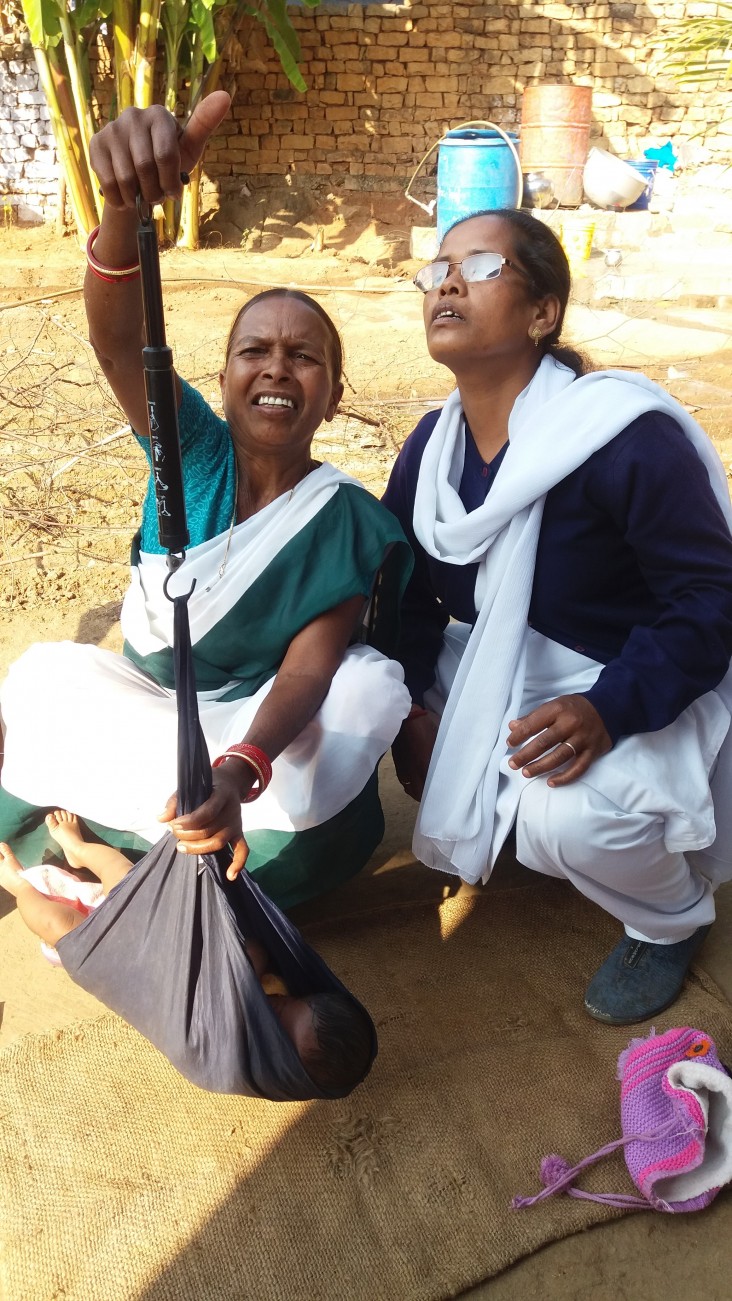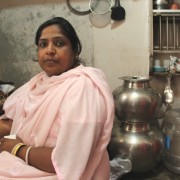 A community health worker prepares to weigh a newborn at his home in the Haridwar district of Uttarakhand state.
Amrita Misra for USAID
A community health worker prepares to weigh a newborn at his home in the Haridwar district of Uttarakhand state.
Amrita Misra for USAID
 A community health worker prepares to weigh a newborn at his home in the Haridwar district of Uttarakhand state.
Amrita Misra for USAID
A community health worker prepares to weigh a newborn at his home in the Haridwar district of Uttarakhand state.
Amrita Misra for USAID
Speeches Shim
Health care workers Kanta Devi and Anju Chauhan take turns pressing baby Farhan’s chest as his 24-year-old mother, Husanjahan*, gazes blankly at the two. Devi and Chauhan whisper to each other in between, but Husanjahan neither moves nor blinks. After two minutes of careful investigation, Devi lifts her ear off Farhan’s chest and announces: “The breathing is normal. Everything is fine now.”
Husanjahan, suddenly released from her frozen state, lets out a sigh of relief and broadly smiles at Devi and Chauhan, two health workers who are the saviors of her 42-day-old son.
Born healthy and at a normal weight, Farhan started showing signs of illness within two weeks of birth. When Devi—the local community health worker from India’s Ministry of Health—arrived for her third scheduled visit, Farhan was not eating and was less active than earlier.
“Farhan was breathing much faster than normal at 70 breaths per minute, he had nasal flaring and there was severe chest in-drawing. I knew these were signs of acute respiratory infection,” recalls Devi.
Knowing that time was of the essence, Devi immediately reached out to Chauhan, the auxiliary nurse midwife at the nearest public health facility. Suspecting that Farhan was suffering from a severe bacterial infection, Chauhan decided to administer the injectable gentamicin antibiotic and amoxicillin syrup to the ailing baby. For the next seven days, Chauhan arrived daily at Farhan’s home to provide him the life-saving drugs. And after a seven-day antibiotic course and numerous follow-up visits, Farhan survived a serious infection and is now thriving.
In the Haridwar district of the Indian state of Uttarakhand, where Farhan lives, scarce access to health care facilities costs the lives of 64 infants out of every 1,000 live births. Shockingly, out of these, 63 percent of babies die within their first four weeks of birth.
“In 2014, the Government of India had released guidelines to roll out injectable gentamicin to treat newborn bacterial infections, one of the leading causes of newborn deaths in India. However, only a few states were able to do so,” says Sachin Gupta, maternal and child health specialist at USAID/India.
In May 2014, USAID launched a project to expand the initiative.
“Under this project, we are demonstrating an umbrella of models, including the roll-out of injectable gentamicin, to reduce maternal and child deaths in 30 high-priority districts across six Indian states. The project works on strengthening health systems, especially delivery quality and increasing uptake of health care services, and training and mentoring health care service providers,” Gupta explains.
Life Savers
In baby Farhan’s district, Chauhan and 240 trained health care workers like her received antibiotics and training to screen newborns for danger signs and to assess eligibility for administering gentamicin.
“The project started supporting the state government in March this year in the pilot district of Haridwar and, within four months, 20 infants have been given injectable gentamicin,” says Dr. Amrita Misra, senior technical adviser of child health at John Snow Inc., India, which is partnering with USAID on the project.
“The reason why Farhan lives today is because of timely training and availability of antibiotics. It was also because the community health worker Kanta did not waste a minute in reaching out to me,” says Chauhan.
But despite the availability of the right drugs and trained frontline health care workers, Chauhan shares that treating Farhan came with its own difficulty.
Husanjahan, who lives in the village with five children while her husband is away in the city for work, became easy prey for the local unqualified “doctor,” who had no formal degree or training and who tried to exploit her situation for easy money.
“The doctor would come every day to my house and dissuade me from seeking the treatment from Anju. He would tell me, ‘Why are you giving such a small baby so many injections? I will offer less invasive and better treatment.’ But somehow, I began to trust Anju and Kanta more,” says the appreciative mother.
With a resolve to help mothers like Husanjahan, the project has played a pivotal role in reducing preventable mother and child deaths across six states in India, which together account for 58,000 newborn deaths. USAID’s success in these high-priority districts are now being scaled up across nine states by India’s Ministry of Health, which has invested more than $71 million.
“In the two states of Uttarakhand and Jharkhand where the project is testing the gentamicin model, if efforts are sustained till 2020, almost 17,000 newborn lives can be saved by administering of antibiotics by community health care workers,” says Misra.
Back in her home, as Devi and Chauhan get up to leave a sleeping Farhan, Husanjahan hands them both a small bite of jaggery as a token of her appreciation for their efforts. Devi gladly eats the piece and, before leaving, reminds Husanjahan to keep breastfeeding the baby and to call her at the sight of any distress in Farhan.
This is her last visit to Farhan as he is now 42 days old. Each community health worker conducts seven home visits to review a newborn’s growth and development at specified intervals till the baby is 42 days old. But Chauhan explains that Farhan is special, and the baby will always stay with her as a sweet memory.
“He is the first baby I treated. When I first saw him, he was only 13 days old and I was so nervous because, if he did not get better, people in this village would not trust me. But seeing him sleep so peacefully, I feel I can manage a baby of any age now. Farhan has strengthened my resolve to treat without fear,” says a smiling Chauhan.
*Some Indians use only one name.
Arti Bhanot is a knowledge management consultant with John Snow Inc., India.





Comment
Make a general inquiry or suggest an improvement.